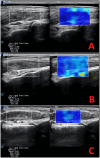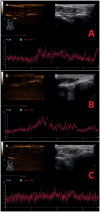Assessment of extensor hallucis brevis stiffness and microcirculation in diabetes: shear wave elastography and contrast-enhanced ultrasound
- PMID: 40771279
- PMCID: PMC12326149
- DOI: 10.3389/fendo.2025.1639270
Assessment of extensor hallucis brevis stiffness and microcirculation in diabetes: shear wave elastography and contrast-enhanced ultrasound
Abstract
Background: Diabetic foot complications, driven by microvascular dysfunction, remain a leading cause of morbidity and amputations. Early detection of microcirculatory and biomechanical alterations in vulnerable muscles, such as the extensor hallucis brevis (EHB), may contribute to risk stratification. However, noninvasive tools for quantifying these changes are lacking.
Methods: This cross-sectional study enrolled 90 participants stratified into healthy controls, uncomplicated type 2 diabetes (T2DM), and T2DM with microvascular complications (MC). Shear wave elastography (SWE) measured EHB stiffness (mean Young's modulus, Emean), while contrast-enhanced ultrasound (CEUS) assessed perfusion dynamics (transcapillary transit time [ΔAT], net enhancement intensity [ΔPI]). Diagnostic accuracy and reproducibility were evaluated via ROC analysis and intra-class correlation coefficients (ICC).
Results: Emean increased progressively across groups (control: 11.88 kPa; T2DM: 15.78 kPa; T2DM+MC: 18.57 kPa; P < 0.01). T2DM+MC exhibited prolonged ΔAT (89.5 s vs. 50.5 s in controls) and reduced ΔPI (5.0 dB vs. 7.0 dB; P < 0.01). ROC analysis demonstrated high diagnostic accuracy for ΔAT (AUC = 0.970), Emean (AUC = 0.947), and ΔPI (AUC = 0.931) in detecting MC. Both SWE and CEUS showed excellent reproducibility (ICC > 0.80).
Conclusion: SWE and CEUS provide robust, noninvasive biomarkers for early diabetic microvascular complications. The EHB's unique susceptibility to stiffness and perfusion deficits highlights its clinical value, which may facilitate diabetic foot risk assessment and guide timely interventions to mitigate ulceration and amputations.
Keywords: diabetes; elasticity; microcirculation; skeletal muscle; ultrasound diagnosis.
Copyright © 2025 Yan, Cai, Li, Huang, Guo, Lin and Lyu.
Conflict of interest statement
The authors declare that the research was conducted in the absence of any commercial or financial relationships that could be construed as a potential conflict of interest.
Figures



Similar articles
-
Impact of Contrast-Enhanced Ultrasound on Hepatic Two-Dimensional Shear Wave Elastography: Does Elastography Need to be Performed Before Contrast Administration?Ultrasound Med Biol. 2025 Sep;51(9):1564-1570. doi: 10.1016/j.ultrasmedbio.2025.05.029. Epub 2025 Jun 27. Ultrasound Med Biol. 2025. PMID: 40581587
-
Application Value and Clinical Correlation of Ultrasonic Shear Wave Elastography in Chronic Kidney Disease.Echocardiography. 2025 Jul;42(7):e70231. doi: 10.1111/echo.70231. Echocardiography. 2025. PMID: 40560645
-
Radiomic-enhanced multimodal ultrasound for early detection of acute kidney injury secondary to renal vein thrombosis: a preclinical diagnostic modeling study.Ren Fail. 2025 Dec;47(1):2525472. doi: 10.1080/0886022X.2025.2525472. Epub 2025 Jul 1. Ren Fail. 2025. PMID: 40590177 Free PMC article.
-
Shear-wave elastography for the evaluation of tendinopathies: a systematic review and meta-analysis.Radiol Med. 2024 Jan;129(1):107-117. doi: 10.1007/s11547-023-01732-4. Epub 2023 Oct 31. Radiol Med. 2024. PMID: 37907673
-
Is musculoskeletal pain associated with increased muscle stiffness? Evidence map and critical appraisal of muscle measurements using shear wave elastography.Clin Physiol Funct Imaging. 2024 May;44(3):187-204. doi: 10.1111/cpf.12870. Epub 2024 Jan 9. Clin Physiol Funct Imaging. 2024. PMID: 38155545
References
-
- Jacob-Brassard J, Al-Omran M, Stukel TA, Mamdani M, Lee DS, Papia G, et al. The influence of diabetes on temporal trends in lower extremity revascularization and amputation for peripheral artery disease: a population-based repeated cross-sectional analysis. Diabetes Med. (2023) 40:e15056. doi: 10.1111/dme.15056, PMID: - DOI - PubMed
-
- Wang K, Wang Y, Shi W, Shen K, Tao K, Ling R, et al. Diagnosis and treatment of diabetic foot ulcer complicated with lower extremity vasculopathy: consensus recommendation from the Chinese Medical Association (CMA), Chinese Medical Doctor Association (CMDA). Diabetes Metab Res Rev. (2024) 40:e3776. doi: 10.1002/dmrr.3776, PMID: - DOI - PubMed
MeSH terms
Substances
LinkOut - more resources
Full Text Sources
Medical
Miscellaneous

